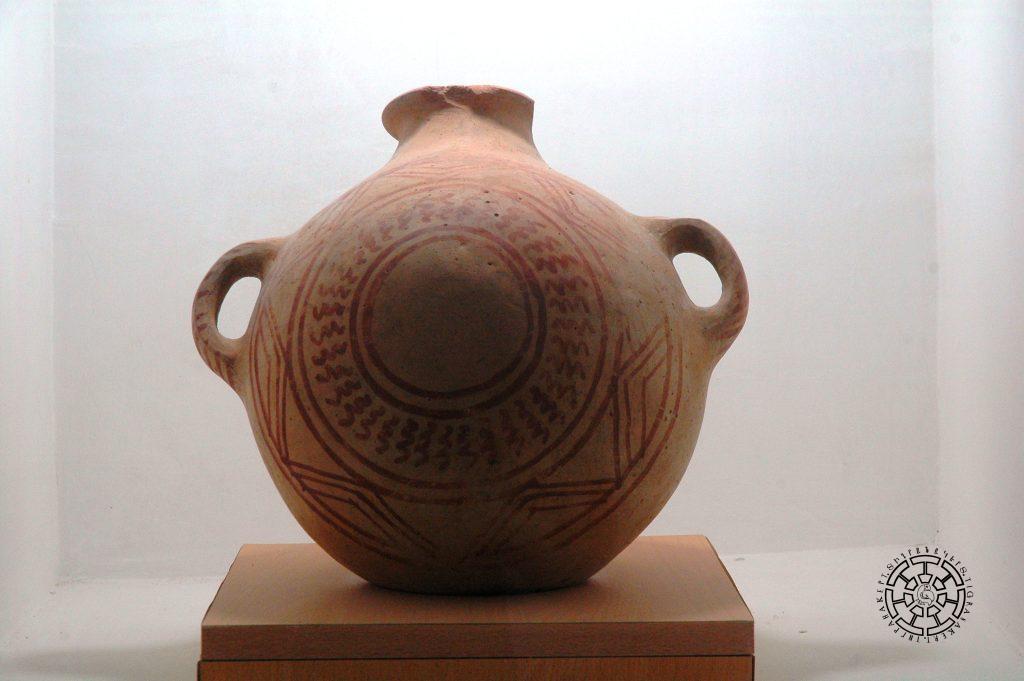Museum
Among the initiatives aimed at popularizing Tigranakert, one of the significant steps was the creation of the archaeological museum of Tigranakert within the monument’s own territory. The 18th-century castle on the monument’s premises underwent renovation with funding from the Tourism Department of the NKR (Nagorno-Karabakh Republic) government (Fig. 1, 2). Parts of the rooms extending along the perimeter of the courtyard were also renovated and transformed into museum exhibition halls. The grand opening of the Tigranakert Museum occurred on May 30, 2010. The event was attended by NKR President Bako Sahakyan, Prime Minister Ara Harutyunyan, and the Primate of the Diocese of Artsakh, Pargev Martirosyan, who consecrated the museum. Thousands of people from various places in Artsakh and Armenia gathered in Tigranakert to partake in the event, which resembled a festive celebration with plays and concerts, exhibitions and sales of folk arts and crafts, and tastings of delicious Artsakh snacks and drinks.
The expedition, led by Hamlet Petrosyan and architect Lyuba Kirakosyan, developed the concept of the Tigranakert archaeological museum, drafted a detailed plan, and technically implemented the exhibition. The museum consists of a lobby and two exhibition halls. In the lobby, facilities were set up for the screening of films related to Tigranakert, while deep niches in the walls were utilized to display sherds found by chance in the vicinity of Tigranakert.
The primary exhibition, dedicated to Tigranakert, was housed in two interconnected halls. The first hall was nearly square in plan, while the second was narrower and elongated. Display elements included glass-enclosed niches, cases, tables, open pedestals, vertical panels with stands, and a horizontal rod running approximately two meters high.
The first hall is more introductory in nature. Here, visitors can explore the history of the city’s discovery and the excavations of the Fortified Quarter through displays suspended from horizontal poles. Deep niches in the walls showcase some of the most remarkable complete antique and medieval vessels (Fig. 3), while archaeological materials found in the immediate surroundings of the city are presented on a glass table and in cases. Additionally, in 2012, a corner dedicated to the pithos burial excavated in 2010 was opened in this hall (Fig. 4).
In the second hall, the exhibition is organized into three series. Stands fixed on vertical panels depict the process of Tigranakert excavations using textual, drawing, and photographic materials (Fig. 5). Rectangular and square tables, closed with glass lids, showcase excavated materials, primarily pottery, small glass, stone, and bone objects. The variety of material is extensive, including antique colored and medieval glazed pottery, fragments of early Christian stone crosses and cross compositions, glass vessels and bracelets, and the clay disc with an Armenian inscription (Fig. 6). In the third row, large architectural details of the basilica church are displayed on open tables, including a base, a column, decorated capitals, and fragments of a cornice.
The museum welcomed up to thirty thousand visitors annually. Despite Nagorno Karabakh not being an internationally recognized state and many governments not advising their citizens against visits, twenty percent of the museum’s visitors were Armenians and Diaspora Armenians. Notably, among them were a significant number of citizens from Switzerland, the United States, Italy, Canada, and France.
The 44-day war and the evacuation of the archaeological museum of Tigranakert
During the 44-day war, Tigranakert became a target of enemy shelling, despite our repeated warnings. As a result, the archaeological camp of Tigranakert was completely destroyed. Artsakh authorities and our research team could not allow Tigranakert Archaeological Museum to suffer such a fate. The museum collections were successfully evacuated to a secure location. The archaeological findings of the Tigranakert excavations are the property of the Artsakh people. The political non-recognition of Artsakh, occupation, and forced displacement cannot diminish its indigenous people’s right to their cultural heritage, including the right to manage their material cultural heritage. The Azerbaijani strategy of depriving the people of Artsakh of their cultural heritage is a continuation of the genocide of Armenian cultural heritage. Genocide, which we have witnessed for decades; genocide, which culminated in the destruction of thousands of khachkars in Jougha (Julfa) in 2005-2006; and cultural genocide, which gained momentum during the recent aggression of Azerbaijan and Turkey, became a daily practice. Such actions cannot be justified by fake political statements and artificial accusations. Despite these challenges, our team remains committed to continuing our research, popularizing the cultural heritage of Artsakh, and exposing Azerbaijani vandalism. Aggression, military supremacy, ethnic cleansing, and threats against Armenians are not eligible. They cannot deprive the people of Artsakh of their inherent right to preserve their identity through their cultural heritage.





